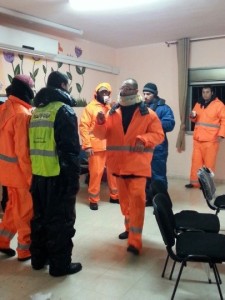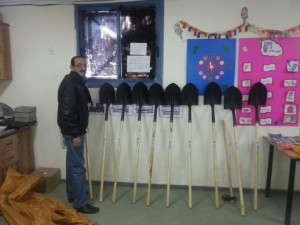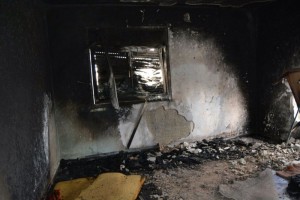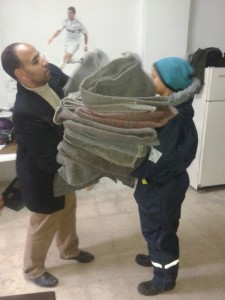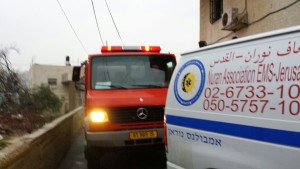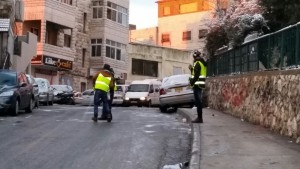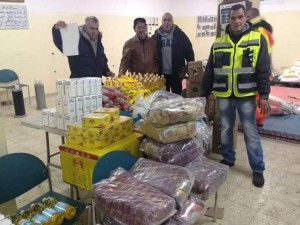Beginning of January 2015, the whole city of Jerusalem braced for what was touted to be a repeat of the Great Storm of 2013 – heavy snow pileups, cold temperatures, strong winds, the works. While pictures of snow in Jerusalem are beautiful, dealing with the effects of such weather, can be disastrous. And for Palestinian residents of East Jerusalem – where infrastructure is weak and housing is crowded to begin with, where services are inaccessible in Arabic, where bureaucratic and other restrictions often prevent Israeli emergency services and service providers from responding in real time – the effects of a severe snow storm can be disastrous even more, and potentially fatal. It is for this reason that the Emergency Readiness Networks (ERNs) were first formed in 2012. In the storm of December 2013, they, together with our MiniActive network of women volunteers, acted tirelessly and valiantly around the clock to help residents weather the storm. This year, with a network of ERNs in 10 neighborhoods throughout Palestinian neighborhoods in East Jerusalem, they again joined forces with MiniActive to help ensure residents’ safety and enable them to get through the storm.
Utilizing lessons learned from last year, the ERN’s worked in impressive coordination with the MiniActive network. The ERN’s ensured that the roads were safe and clear, fires were being fought, residents rescued, and ambulances transported the sick to hospitals. The MiniActive network helped tens of thousands in their support and organization. They led drives for blankets, heaters, and food, which the ERN members distributed to the old, sick and needy. They coordinated complaints to the electric company for power outages, the water company for flooding, and to other service providers as needed.
As with any emergency preparation, the real work did not begin on January 6, when the rain and gale-force winds started. In the week beforehand ERN heads in Jerusalem underwent refresher exercises, where they reviewed the various protocols. They were then sent to renew contact with the various professionals, owners of the bulldozers, 4×4’s and other heavy equipment, take stock of shovels, hoes, salt, and more. Also, a special emergency grant from the Jerusalem Foundation enabled the MiniActive network to distribute over 200 warm blankets to needy households. The MiniActive Facebook page also served as a massive bulletin board, posting guidelines from the ERNs, emergency numbers, and helpful information produced by the municipality.
Thus, when the storm hit on January 6-7, everyone was ready, or as ready as they could be. Snow plows worked in the north of the city, clearing the road from Shuafat to the Qalandia crossing as soon as there was snow on the road. At the same time, crews in Silwan, Ras el-Amud and Umm Tuba were distributing heaters and blankets to needy residents. When houses in A-Tur and Issawiya were flooded, the families were evacuated, the problems were reported, and the families received help in relocating until the problems were fixed.
Unfortunately, there were a number of extreme incidents – house fires in the Shuafat Refugee Camp and other places, and a house that partially collapsed in the Old City. But the ERNs worked tirelessly to ensure the residents’ safety, and MiniActive was active in collecting money and furniture and a range of household items to help the families get back on their feet as quickly as possible.
Efficient, Coordinated Work Result of Extended Preparation
The ERNs were able to act so quickly and efficiently because they had undergone extensive training and drilling, months beforehand. In 2013 we supervised a ‘Training the Trainers’ course, operated by the Palestinian organization “the Jerusalem Emergency Readiness Teams”, that enabled graduates to initiate ERNs in their own neighborhoods. The 8 new ERNs, which were formed and trained throughout 2014, are the result of this course. They include:
- 15 participants from the Shuafat refugee camp, who were trained from 30/9 until 30/12/2013
- 22 participants from Kufr Aqeb, who were trained from 15/10/2013 to 28/01/2014
- 19 participants from Isawiyya, who were trained from 26/10/2013 to 15/02/2014
- 14 participants from Sheikh Sa’ad, who were trained from 1/3/2014 until 27/04/2014
- 14 participants from Wadi Al-Joz, who were trained from 12/4/2014 until 20/07/2014
- 17 participants from Shuafat, who were trained from 10/9/2014 until 11/12/2014
- 17 participants from Umm Tuba, who finished training at the end of 2014
- 14 participants from Bet Hanina, who will finish the training on February 5, 2015
They joined the veteran Network in Sur Baher, which was originally founded in 2012 and the Jabel El-Mukaber Network, which was founded in 2013.
The establishment of an ERN requires a detailed planning process. First, appropriate team members are recruited, and the exact physical boundaries of the ERN are defined. The next step is to map the various aspects of action: what type of potential emergencies they will be prepared to respond to; what types of special conditions exist in that neighborhood (geographical terrain, roads, roadblocks, population overcrowding, structural weaknesses, etc.); what types of resources exist in the neighborhood – professionals, equipment, facilities, etc. Action plans are then defined, including establishing which emergency providers are to respond to which scenarios, and how they can be reached. The organizational structure of the ERN must also be defined and responsibilities distributed – a volunteer coordinator is chosen, as are a logistics team, a team that maintains contact with Israeli service providers, a social worker team, medical team, evacuation team and more, and the responsibilities of each person on the team are determined. The last and final step are simulations of emergency situations to ensure that the process works smoothly.
Taking Emergency Readiness – and Community Solidarity-Building – to the Next Step
We have come a long way, but much remains to be done. ERNs have been established in less than half of the Palestinian neighborhoods in East Jerusalem. Existing teams must be further cultivated to maintain and improve their efficiency. In addition, the plan is to further develop existing teams, so that current members themselves become team leaders, with each person in charge of a separate aspect, such as communication, facilities, equipment, the needy, and team leaders must recruit and train those teams. A detailed facilities mapping has also yet to be performed in the neighborhoods. This mapping will include the locations of different facilities, such as mosques, schools, doctors’ offices, bakeries; their contact information and how they can be used in an emergency.
The ERNs and MiniActive have shown us once again that responding to emergencies is not just about repairing electricity and draining flooding. Both projects aim to create teams and networks that build community as well. People with different areas of expertise from medicine, social work, electricity to bulldozer operator – all work together to help their neighbors and their neighborhood.
We would like to thank Jerusalem Foundation for its continued support of this project, and the Daimler AG, which supports the project via the Jerusalem Foundation. And of course, this project would be nowhere without the training and on-site coordination of the “Jerusalem Emergency Readiness Teams” organization, and the volunteers from the ERNs and MiniActive.

